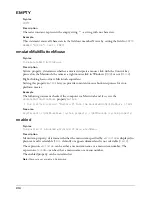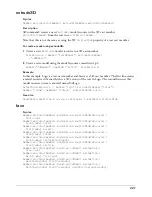
220
Include only those behaviors in
on EvalScript
that you want users to control; for security
reasons, don’t give complete access to behaviors.
Note:
If you place a return at the end of your EvalScript handler, the value returned can be used by JavaScript in
the browser.
Examples
This shows how to make the playhead jump to a specific frame depending on what frame is
passed in as the parameter:
on EvalScript aParam
go frame aParam
end
This handler runs the statement
go frame aParam
if it receives an
EvalScript
message that
includes dog, cat, or tree as an argument:
on EvalScript aParam
case aParam of
"dog", "cat", "tree": go frame aParam
end case
end
A possible calling statement for this in JavaScript would be
EvalScript ("dog")
.
This handler takes an argument that can be a number or symbol:
on EvalScript aParam
if word 1 of aParam = "myHandler" then
do aParam
end if
end
The following handler normally requires a string as its argument. The argument is received as a
symbol and then converted to a string within the handler by the
string
function:
on myHandler aParam
go to frame string(aParam)
end
See also
externalEvent
,
return (keyword)
eventPassMode
Syntax
sprite(
whichFlashSprite
).eventPassMode
the eventPassMode of sprite
whichFlashSprite
member(
whichFlashMember
)
.
eventPassMode
the eventPassMode of member
whichFlashMember
Description
Flash cast member property and sprite property; controls when a Flash movie passes mouse events
to behaviors that are attached to sprites that lie underneath the flash sprite. The
eventPassMode
property can have these values:
•
#passAlways
(default)—Always passes mouse events.
•
#passButton
—Passes mouse events only when a button in the Flash movie is clicked.
•
#passNotButton
—Passes mouse events only when a nonbutton object is clicked.
•
#passNever
—Never passes mouse events.
Содержание DIRECTOR MX-LINGO DICTIONARY
Страница 1: ...Lingo Dictionary Macromedia Director MX...
Страница 756: ...Index 756...
















































